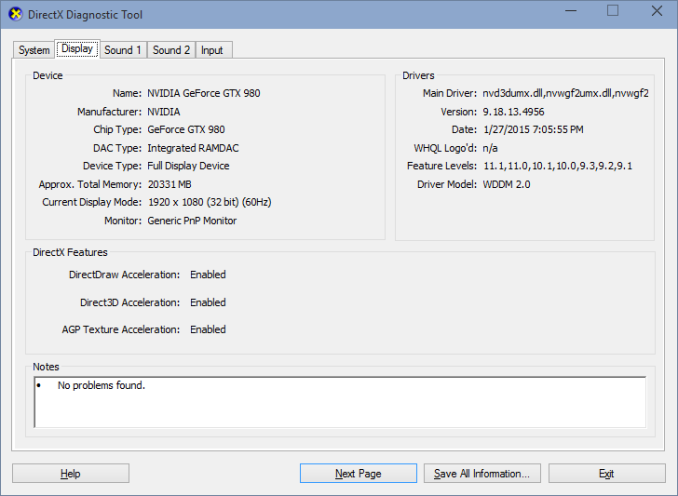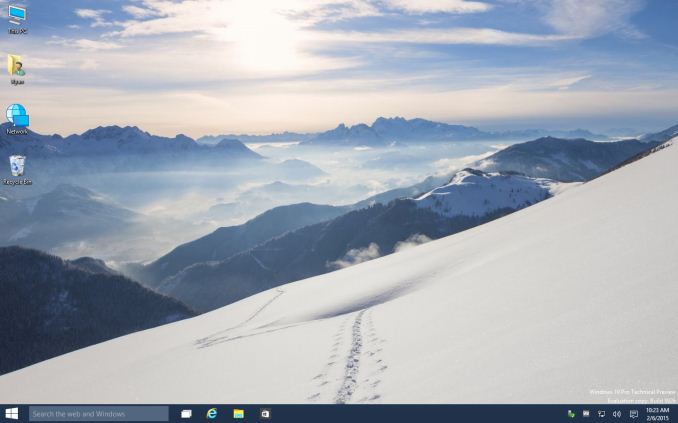The DirectX 12 Performance Preview: AMD, NVIDIA, & Star Swarm
by Ryan Smith on February 6, 2015 2:00 PM EST- Posted in
- GPUs
- AMD
- Microsoft
- NVIDIA
- DirectX 12
The Current State of DirectX 12 & WDDM 2.0
Although DirectX 12 is up and running in the latest public release of Windows 10, it and many of its related components are still under development. Windows 10 itself is still feature-incomplete, so what we’re looking at here today doesn’t even qualify as beta software. As a result today’s preview should be taken as just that: an early preview. There are still bugs, and performance and compatibility is subject to change. But as of now everything is far enough along that we can finally get a reasonable look at what DirectX 12 is capable of.
From a technical perspective the DirectX 12 API is just one part of a bigger picture. Like Microsoft’s last couple of DirectX 11 minor version upgrades, DirectX 12 goes hand-in-hand with a new version of the Windows Display Driver Model, WDDM 2.0. In fact WDDM 2.0 is the biggest change to WDDM since the driver model was introduced in Windows Vista, and as a result DirectX 12 itself represents a very large overhaul of the Windows GPU ecosystem.
Top: Radeon R9 290X. Bottom: GeForce GTX 980
Microsoft has not released too many details on WDDM 2.0 so far – more information will be released around GDC 2015 – but WDDM 2.0 is based around enabling DirectX 12, adding the necessary features to the kernel and display drivers in order to support the API above it. Among the features tied to WDDM 2.0 are DX12’s explicit memory management and dynamic resource indexing, both of which wouldn’t have been nearly as performant under WDDM 1.3. WDDM 2.0 is also responsible for some of the baser CPU efficiency optimizations in DX12, such as changes to how memory residency is handled and how DX12 applications can more explicitly control residence.
The overhauling of WDDM for 2.0 means that graphics drivers are impacted as well as the OS, and like Microsoft, NVIDIA and AMD have been preparing for WDDM 2.0 with updated graphics drivers. These drivers are still a work in progress, and as a result not all hardware support is enabled and not all bugs have been worked out.
| DirectX 12 Support Status | ||||
| Current Status | Supported At Launch | |||
| AMD GCN 1.2 (285) | Working | Yes | ||
| AMD GCN 1.1 (290/260 Series) | Working | Yes | ||
| AMD GCN 1.0 (7000/200 Series) | Buggy | Yes | ||
| NVIDIA Maxwell 2 (900 Series) | Working | Yes | ||
| NVIDIA Maxwell 1 (750 Series) | Working | Yes | ||
| NVIDIA Kepler (600/700 Series) | Working | Yes | ||
| NVIDIA Fermi (400/500 Series) | Not Active | Yes | ||
In short, among AMD and NVIDIA their latest products are up and running in WDDM 2.0, but not on all of their earlier products. In AMD’s case GCN 1.0 cards are supported under their WDDM 2.0 driver, but we are encountering texturing issues in Star Swarm that do not occur with GCN 1.1 and later. Meanwhile in NVIDIA’s case, as is common for NVIDIA beta drivers they only ship with support enabled for their newer GPUs – Kepler, Maxwell 1, and Maxwell 2 – with Fermi support disabled. Both AMD and NVIIDA have already committed to supporting DirectX 12 (and by extension WDDM 2.0) on GCN 1.0 and later and Fermi and later respectively, so while we can’t test these products today, they should be working by the time DirectX 12 ships.
Also absent for the moment is a definition for DirectX 12’s Feature Level 12_0 and DirectX 11’s 11_3. Separate from the low-level API itself, DirectX 12 and its high-level counterpart DirectX 11.3 will introduce new rendering features such as volume tiled resources and conservative rasterization. While all of the above listed video cards will support the DirectX 12 low-level API, only the very newest video cards will support FL 12_0, and consequently be fully DX12 compliant on both a feature and API basis. Like so many other aspects of DirectX 12, Microsoft is saving any discussion of feature levels for GDC, at which time we should find out what the final feature requirements will be and which (if any) current cards will fully support FL 12_0.
Finally, with Microsoft’s announcement of their Windows 10 plans last month, Microsoft is also finally clarifying their plans for the deployment of DirectX 12. Because DirectX 12 and WDDM 2.0 are tied at the hip, and by extension tied to Windows 10, DirectX 12 will only be available on Windows 10. Windows 8/8.1 and Windows 7 will not be receiving DirectX 12 support.
| DirectX 12 Supported OSes | ||||
| Will Support DX12? | Required WDDM Version | |||
| Windows 10 | Yes | 2.0 | ||
| Windows 8.1 | No | N/A | ||
| Windows 8 | No | N/A | ||
| Windows 7 | No | N/A | ||
Backporting DirectX 12 to earlier OSes would require backporting WDDM 2.0 as well, which brings with it several issues due to the fact that WDDM 2.0 is a kernel component. Microsoft would either have to compromise on WDDM 2.0 features in order to make it work on these older kernels, or alternatively would have to more radically overhaul these kernels to accommodate the full WDDM 2.0 feature set, the latter of which is a significant engineering task and carries a significant risk of breaking earlier Windows installations. Microsoft has already tried this once before in backporting parts of Direct3D 11.1 and WDDM 1.2 to Windows 7, only to discover that even that smaller-scale project had compatibility problems. A backport of DirectX 12 would in turn be even more problematic.
The bright side of all of this is that with Microsoft’s plans to offer Windows 10 as a free upgrade for Windows 7/8/8.1 users, the issue is largely rendered moot. Though DirectX 12 isn’t being backported, Windows users will instead be able to jump forward for free, so unlike Windows 8 this will not require spending money on a new OS just to gain access to the latest version of DirectX. This in turn is consistent with Microsoft’s overall plans to bring all Windows users up to Windows 10 rather than letting the market get fragmented among different Windows versions (and risk repeating another XP), so the revelation that DirectX 12 will not get backported has largely been expected since Microsoft’s Windows 10 announcement.
Meanwhile we won’t dwell on the subject too much, but DirectX 12 being limited to Windows 10 does open up a window of opportunity for Mantle and OpenGL Next. With Mantle already working on Windows 7/8 and OpenGL Next widely expected to be similarly portable, these APIs will be the only low-level APIs available to earlier Windows users.













245 Comments
View All Comments
OrphanageExplosion - Tuesday, February 10, 2015 - link
Sony already has its low-level API, GNM, plus its DX11-a-like GNMX, for those who need faster results, easier debugging, handling of state etc.Gigaplex - Monday, February 9, 2015 - link
The consoles already use bare metal APIs. This will have minimal impact for consoles.Bill McGann - Tuesday, February 10, 2015 - link
D3D11.x is garbage compared to GNM (plus the XbOne HW is garbage compared to the PS4). The sad fact is that the XbOne desperately needs D3D12(.x) in order to catch up to the PS4.Notmyusualid - Monday, February 9, 2015 - link
Hello all... couldn't find any MULTI-GPU results...So here are mine:
System: M18x R2 3920XM (16GB RAM 1866MHz CAS10), Crossfire 7970Ms.
Test: Star Swarm Perf demo RTS, all Extreme setting.
Ambient temp 31C, skype idling in background, and with CPU ALL at stock settings:
Mantle: fps max 99.03 min 9.65 AVG 26.5
DX11: fps max 141.56 min 3.26 AVG 11.6
CPU at 4.4GHz x 4 cores, fans 100%, skype in background again:
Mantle: fps max 51.03 min 7.26 AVG 26.2 - max temp 94C
DX11: fps max 229.06 min 3.6 AVG 12.3 - max temp 104C + thus cpu throtteled at 23%.
So I guess there are good things coming to PC gamers with multi-gpu's then. Alas, being a mere mortal, I've no access to DX12 to play with...
Anyone care to offer some SLI results in return?
lamebot - Monday, February 9, 2015 - link
I have been reading this article page by page over the weekend, giving myself time to take it in. The frame times from each vendor under DX11 is very interesting. Thank you for a great, in depth article! This is what keeps me coming back.ChristTheGreat - Monday, February 9, 2015 - link
Can it be only a WIndows 10 Driver problem or optimisation for these result with the R9 290/X? On windows 8.1, 4770k 4.3ghz and R9 290 1100/1400, I do 40avg D3D11 and 66avg Mantle.. Scenario: follow, Detail: extreme...ChristTheGreat - Monday, February 9, 2015 - link
Oh well, I saw that you guys use the Asus PQ321, so running in 3 840 x 2 160?Wolfpup - Monday, February 9, 2015 - link
Good, can Mantle go away now? The idea of moving BACK to proprietary APIs is a terrible one, unless the only point of it was to push Microsoft to make these fixes in Direct X."Stardock is using the Nitrous engine for their forthcoming Star Control game"
I didn't know! This is freaking awesome news. I love love love Star Control 2 on the 3DO. Liked 1 on the Genesis too, but SC2 on the 3DO (which I think is better than the PC version) is not unlike Starflight-and somewhat like Mass Effect.
Wolfpup - Monday, February 9, 2015 - link
Forgot to mention... I also think AMD needs to worry about making sure their DirectX/Open GL drivers are flawless across years of hardware before wasting time on a proprietary API too...lordken - Monday, February 9, 2015 - link
Sorry but are you just amd hater or something?imho AMD did great thing with mantle and possibly pushed M$ to come with DX12 (or not we will never know). But that aside how about you think about some advantages mantle has?
I think that when they bring it to linux (they said they would, not sure about current status) that will be nice advantage as I guess native api would work better than wine etc. With more recent games (thanks to new engines) comming to linux would probably benefit more if they would run on mantle.
And nonetheless how about ppl that wont move to Win10 (for whatever reason)? Mantle on Win7/8 would still be huge benefit for such ppl. Not to mention that there will be probably more games with mantle than with DX12 in very close feature.
Plus if they work out console & pc mantle aspect it could bring better console ports to PC, even if game devs would be lazy to do proper optimalization mantle should pretty much eliminate this aspect (though only for amd gpu).
But either way I dont see much reason why should mantle go. I mean once it is included in all/most bigger engines (already in cryengine,frostbite,unreal) and it works what reason would be to trash something that is usefull?
btw funny how "M$ would need to do huge kernel rework to bring DX12 to Win7/8" while mantle, which does similar thing, is easily capable to be "OS version independent" (sure it is amd specific but still)
PS:What about amd drivers? They are fine imho, never had problem in last years. (you see personal experience is not a valid argument)